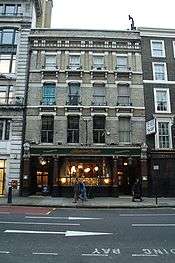Princess Louise, Holborn
The Princess Louise is a public house situated on High Holborn, a street in central London. Built in 1872, it is best known for its well-preserved 1891 Victorian interior, with wood panelling and a series of booths around an island bar. It is a tied house owned by the Samuel Smith Brewery of Tadcaster, Yorkshire.[1]

About
Being located near Bloomsbury, the British Museum and the University of London, it is patronised by academics.[2]
Building
The building is protected by its Grade II* listing[3][4] and has what has been described as "a rich example of a Victorian public house interior", by William B Simpson and Sons; who contracted out the work.[3][4][5] As it is considered so historically significant even the men's toilets, with their marble urinals, are listed.[3][4] The pub, which is also listed on National Inventory of Historic Pub Interiors, was refurbished in 2007.[6] The pub is unusual in that it retains its snob screens.[6]
In June 2009, the pub was joint winner of the best refurbishment class of the 2008 Pub Design Awards awarded annually by CAMRA.[7] Author Peter Haydon included the Princess Louise in his book The Best Pubs in London and rated it No. 5 in the capital, saying it had "possibly the best preserved Victorian pub interior in London".[8]
History
The pub was operated by Regent Inns from 1990 until 1998, when the lease was taken over by Samuel Smith.
The Princess Louise is also notable for having been the venue for a number of influential folk clubs run by Ewan MacColl and others, which played an important part in the British folk revival of the late 1950s and early 1960s.[9]
Gallery
References
- Brown, Matt (6 May 2011). "10 of the best pubs in London". The Guardian. Retrieved 12 October 2013.
- "To Professor Arthur Terry (1927–2004), in Memoriam". Journal of Iberian and Latin American Studies. 10: 3. 2004. doi:10.1080/1470184042000236297. "I have especially fond memories of several lunchtime beer and sandwich sessions at the "Princess Louise" in Holborn"
- "Princess Louise Public House, Camden". British Listed Buildings. Retrieved 24 March 2013.
- Historic England. "Princess Louise public house (Grade II*) (1378884)". National Heritage List for England. Retrieved 3 January 2015.
- Protz, R.(Ed.), Good Beer Guide 2006, ISBN 1-85249-211-2
- Brandwood, Geoff (2013). Britain's best real heritage pubs. St. Albans: CAMRA. p. 61. ISBN 9781852493042.
- CAMRA Pub Design Awards 2008, CAMRA, 29 June 2009,
This renowned Sam Smith's pub has undergone a comprehensive redesign which has seen the reintroduction of the original, multi-bar layout, complete with bar doors and snob screens. This has made what was already an interesting and worthy pub even more of a pubgoers' icon. After a six-month closure, this celebrated landmark has reopened in a guise which reflects both its incarnation of over a century ago and the modern customer's wish to drink and chat in a cosy, quiet and private environment. This is one instance in which gilding the lily can actually improve the subject.
- Haydon, Peter (26 March 2009). "London's 10 best pubs". The Times. London. Archived from the original on 29 June 2011. Retrieved 3 January 2015.
- Harper, Colin (21 August 2006). Dazzling Stranger: Bert Jansch and the British Folk and Blues Revival. London: Bloomsbury Publishing. pp. 32, 35, 320. ISBN 9780747587255. Retrieved 3 January 2015.
External links
| Wikimedia Commons has media related to Princess Louise, High Holborn. |
- Official website
- CAMRA National Inventory of Historic Pub Interiors
- Beer in the Evening
- pubs.com review